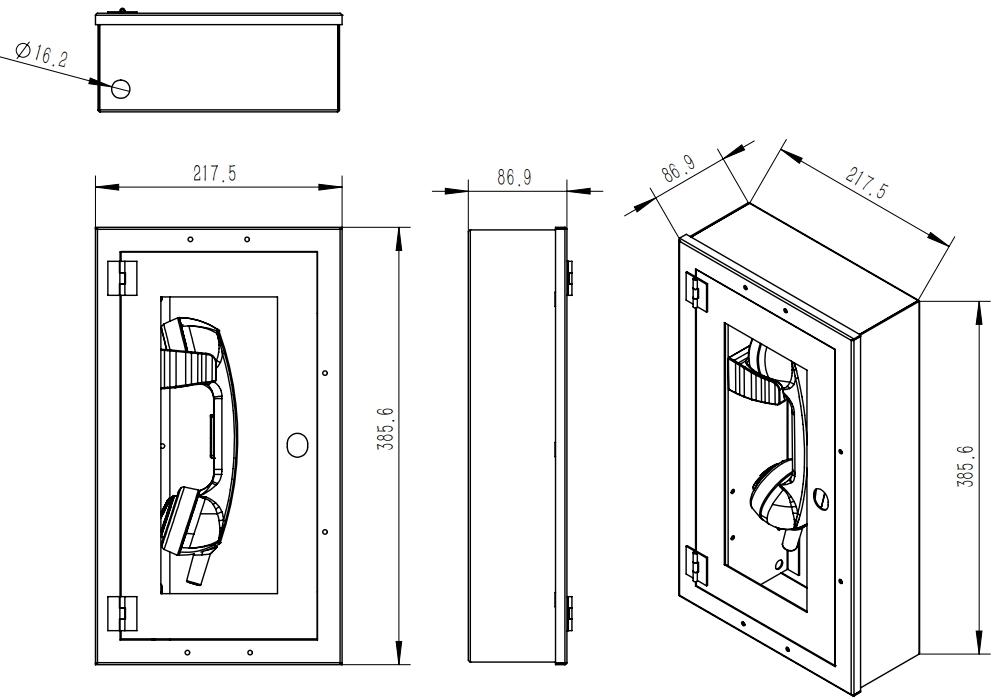
Modern emergency voice communication systems fire telephone technology addresses critical fire safety challenges. These systems ensure reliable communication during emergencies, reducing confusion and delays. Products like the emergency Explosion Proof Telephone and mining Explosion Proof Telephone enhance safety in hazardous environments. Features such as auto dial prison telephone functionality streamline coordination, improving response times and evacuation procedures.
Traditional Fire Safety Challenges
Delayed Communication During Emergencies
During emergencies, delayed communication can have catastrophic consequences. Traditional fire safety systems often rely on outdated methods, such as manual alarms or basic public address systems, which fail to provide immediate and clear instructions. These delays can hinder evacuation efforts and increase the risk of injury or loss of life.
Almost without exception, major safety advances have followed fatal fires rather than preventing them. This reactive pattern continues today, revealing how difficult it is to mobilize political will and resources for safety without the emotional catalyst of tragedy.
In many cases, older buildings exempt from modern safety codes exacerbate these delays. Retrofitting such structures remains costly, but the consequences of inaction, as seen in disasters like the MGM Grand fire, highlight the urgent need for proactive measures.
Lack of Clarity and Coordination in Crisis Situations
Traditional systems often fail to provide clear and specific instructions during emergencies. General alarms or sirens may alert occupants to danger, but they rarely convey actionable information. This lack of clarity can lead to confusion, panic, and uncoordinated evacuations. Without precise communication, emergency responders may struggle to direct occupants to safety or identify areas requiring immediate attention.
Limitations of Traditional Alarm Systems
Traditional alarm systems have significant limitations in effectively alerting occupants. These systems often rely on generic signals, which may not be understood by everyone, especially in diverse or multilingual environments. Historical incidents, such as the Hawaii ballistic missile crisis of 2018, underscore these shortcomings:
- An employee mistakenly sent an alert about a supposed missile threat, causing widespread panic.
- It took 38 minutes to issue a correction, highlighting delays and communication failures.
- The incident eroded public trust in emergency alert systems.
These examples emphasize the need for modern solutions that prioritize speed, clarity, and reliability in emergency communication.
Emergency Voice Communication Systems Fire Telephone: Features and Benefits

Reliable Two-Way Communication for Effective Coordination
Emergency Voice Communication Systems Fire Telephone technology ensures seamless two-way communication during fire emergencies. This feature allows emergency personnel to exchange real-time information, improving situational awareness and reducing confusion. For instance, fire marshals can confirm the status of evacuation zones while coordinating with control room operators. This direct communication minimizes delays and ensures that critical decisions are made promptly.
Two-way communication also enhances operational efficiency by enabling emergency managers to collect feedback from occupants. This feedback helps identify individuals who may require assistance, ensuring no one is left behind. Studies highlight its importance in chaotic situations, where clear and immediate communication can save lives.
- Two-way systems provide real-time feedback, improving situational awareness.
- Emergency personnel can coordinate effectively, reducing miscommunication.
- Managers can track message delivery and identify areas needing attention.
The Joiwo Fire Telephone Type A Outstations JWAT162-2 exemplifies this capability. Its auto-dial function connects users directly to the control panel, ensuring uninterrupted communication even in high-rise buildings or large facilities. This reliability makes it an indispensable tool for fire safety.
Targeted Messaging to Specific Areas or Groups
Unlike traditional alarm systems, Emergency Voice Communication Systems Fire Telephone solutions enable targeted messaging. This feature allows emergency responders to deliver specific instructions to particular zones or groups, ensuring clarity and precision. For example, occupants on higher floors can receive tailored evacuation routes, while those in unaffected areas remain informed without unnecessary panic.
Targeted messaging proves especially valuable in complex environments like schools, hospitals, and high-rise buildings. It ensures that instructions are relevant to the situation, reducing confusion and streamlining evacuation procedures. A case study from Fire and Emergency New Zealand demonstrates how improved communication during Home Fire Safety Visits optimized risk assessment and enhanced safety outcomes.
- Targeted messaging delivers precise instructions to specific areas.
- It minimizes panic by providing relevant information to affected groups.
- Tailored communication improves evacuation efficiency in complex settings.
The JWAT162-2 supports this functionality by connecting key points throughout a facility to a central control room. Its robust design ensures reliable performance, even in challenging conditions, making it a trusted choice for emergency communication.
Enhanced Safety Through Durable and Accessible Design
Durability and accessibility are critical for any Emergency Voice Communication Systems Fire Telephone. The Joiwo Fire Telephone Type A Outstations JWAT162-2 is crafted from high-quality materials like red cold-rolled steel or stainless steel, ensuring it withstands harsh environments. Its IP65 waterproof rating further enhances its reliability, making it suitable for both indoor and outdoor installations.
The design prioritizes accessibility. The bright red handset, housed behind a push door, is easy to locate during emergencies. High-contrast red screen printing ensures visibility, even in low-light conditions. These features make the system user-friendly, allowing occupants to quickly access communication tools when seconds matter most.
Reports on Emergency Responder Communication Enhancement Systems (ERCES) emphasize the importance of durable and accessible designs. These systems ensure reliable communication channels, protecting lives and property during critical situations. The JWAT162-2 aligns with these findings, offering a robust solution that meets the demands of modern fire safety.
- Durable materials ensure long-lasting performance in extreme conditions.
- Accessible design features, such as bright colors and clear labeling, enhance usability.
- Waterproof and weather-resistant construction supports outdoor applications.
By combining durability, accessibility, and advanced functionality, the JWAT162-2 sets a new standard for emergency communication systems. Its thoughtful design ensures that safety remains uncompromised, even in the most challenging scenarios.
Real-World Applications and Success Stories
Case Studies of Emergency Voice Systems in Action
Emergency voice systems have proven their effectiveness in real-world scenarios, demonstrating their ability to save lives and streamline evacuation procedures. One notable case occurred in a high-rise office building during a fire outbreak. The building’s integrated Emergency Voice Communication Systems Fire Telephone enabled fire marshals to coordinate with the control room and direct occupants to safe exits. The system’s auto-dial function ensured uninterrupted communication, allowing responders to confirm evacuation progress and identify areas requiring immediate attention. This swift coordination minimized injuries and prevented fatalities.
Another example comes from a large public stadium during an emergency evacuation caused by a structural issue. Emergency voice systems facilitated targeted messaging to specific sections of the stadium, instructing attendees on safe exit routes. The clear communication reduced panic and ensured an orderly evacuation. Reports from emergency responders highlighted the system’s role in maintaining crowd control and preventing chaos.
Note: These case studies underscore the importance of reliable communication tools in emergencies. They illustrate how modern systems enhance safety and efficiency, even in complex environments.
Examples from High-Rise Buildings, Schools, and Public Spaces
High-rise buildings, schools, and public spaces present unique challenges during emergencies. Emergency voice systems address these challenges by providing tailored solutions for each environment. In high-rise buildings, these systems connect multiple floors to a central control room, ensuring seamless communication across vast vertical spaces. Fire marshals can use the system to relay evacuation instructions and confirm that floors are clear of occupants.
Schools benefit from targeted messaging capabilities. During fire drills or actual emergencies, administrators can direct specific classrooms or wings to evacuate while keeping unaffected areas informed. This precision reduces confusion and ensures the safety of students and staff. Public spaces, such as shopping malls and stadiums, rely on these systems to manage large crowds. Emergency voice systems deliver clear instructions to specific zones, preventing panic and facilitating orderly evacuations.
Tip: Tailored communication improves evacuation efficiency in diverse environments. It ensures that instructions are relevant and actionable, reducing the risk of miscommunication.
Lessons Learned from Implementing Fire Telephones
Implementing fire telephones has provided valuable insights into improving emergency communication systems. One key lesson is the importance of durability and accessibility. Systems like the Joiwo Fire Telephone Type A Outstations JWAT162-2 demonstrate how robust materials and user-friendly designs enhance reliability during critical situations. Organizations have learned that waterproof and weather-resistant features are essential for outdoor installations.
Another lesson involves the integration of advanced technologies. Features like auto-dial functions and targeted messaging have shown their value in reducing response times and improving coordination. Feedback from emergency responders highlights the need for continuous training to ensure personnel can effectively use these systems during crises.
Callout: Investing in modern emergency voice systems not only enhances safety but also builds trust among occupants and responders. Reliable communication tools are a cornerstone of effective emergency management.
Advancements in Technology Enhancing Fire Safety

Integration with Smart Building Systems
Smart building systems are transforming fire safety by integrating advanced technologies with emergency voice communication systems fire telephone solutions. These systems connect fire alarms, sprinklers, and voice alarms into a unified network, enabling faster response times and improved situational awareness. For example, the integration of voice-guided evacuations through the ‘Smart Safety Link’ prioritizes endangered zones, reducing panic and ensuring orderly evacuations.
Modern fire alarm systems also reduce false alarms, saving time and costs. Cloud-connected systems provide real-time monitoring and compliance, allowing facility managers to oversee safety protocols remotely. Studies show that voice evacuation instructions can save up to 30% of response time compared to traditional alarms, highlighting the importance of clear communication during emergencies.
Role of Artificial Intelligence in Emergency Management
Artificial intelligence plays a pivotal role in enhancing fire safety and emergency management. AI-powered systems analyze real-time data from sensors, drones, and historical fire patterns to predict high-risk areas. This predictive capability allows emergency teams to prepare and respond more effectively.
| Application Area | Description |
|---|---|
| Predicting High-Risk Areas | AI analyzes weather patterns, fuel sources, and historical fire data to predict high-risk areas. |
| Enhanced Preparedness and Response | AI-powered ChatBots facilitate realistic emergency scenario training and smart warning systems deliver targeted alerts. |
| Streamlined Recovery | AI analyzes satellite imagery and drone footage to assess damage and prioritize aid effectively. |
AI also supports multilingual communication through chatbots, ensuring critical safety information reaches diverse populations. Social media analysis powered by AI identifies community needs, directing aid to vulnerable groups during recovery efforts.
Future Innovations in Emergency Voice Systems
The future of emergency voice systems promises groundbreaking advancements. IoT technology will enable interconnected networks of sensors, providing comprehensive coverage and faster response times. Innovations like AI-powered sensors and drones will identify fire outbreaks more quickly, enhancing early detection and response accuracy.
Emerging technologies such as VR and AR are expected to revolutionize firefighter training, offering immersive simulations for realistic emergency scenarios. Dry-Flo® technology, which allows non-intrusive testing of fire suppression systems, addresses environmental concerns while maintaining safety standards. These innovations will continue to elevate the reliability and efficiency of emergency voice communication systems fire telephone solutions, ensuring safer environments for all.
Modern emergency voice systems, such as Emergency Voice Communication Systems Fire Telephone, redefine fire safety standards. Their reliable communication and targeted messaging improve emergency response efficiency. Integration with advanced technologies ensures adaptability to evolving safety needs. Organizations adopting these systems create safer environments and protect lives during critical situations.
FAQ
What makes emergency voice systems essential for fire safety?
Emergency voice systems provide clear, real-time communication during crises. They enhance coordination, reduce confusion, and ensure targeted messaging for efficient evacuations and safety management.
How does the JWAT162-2 Fire Telephone improve emergency response?
The JWAT162-2 offers reliable two-way communication, auto-dial functionality, and durable design. These features ensure seamless coordination and accessibility during fire emergencies.
Can emergency voice systems integrate with modern technologies?
Yes, advanced systems integrate with smart building technologies, IoT networks, and AI tools. This integration enhances detection, response, and overall fire safety management.


